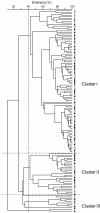Transglucosidase improves the gut microbiota profile of type 2 diabetes mellitus patients: a randomized double-blind, placebo-controlled study
- PMID: 23657005
- PMCID: PMC3658914
- DOI: 10.1186/1471-230X-13-81
Transglucosidase improves the gut microbiota profile of type 2 diabetes mellitus patients: a randomized double-blind, placebo-controlled study
Abstract
Background: Recently, the relationship between gut microbiota and obesity has been highlighted. The present randomized, double-blind, placebo-controlled study aimed to evaluate the efficacy of transglucosidase (TGD) in modulating blood glucose levels and body weight gain in patients with type 2 diabetes mellitus (T2DM) and to clarify the underlying mechanism by analyzing the gut microbiota of T2DM patients.
Methods: This study included 60 patients who received placebo or TGD orally (300 or 900 mg/day) for 12 weeks, and blood and fecal samples were collected before and after 12 weeks. Comparisons of fecal bacterial communities were performed before and after the TGD treatment and were performed between T2DM patients and 10 healthy individuals, using the terminal-restriction fragment length polymorphism analysis.
Results: The Clostridium cluster IV and subcluster XIVa components were significantly decreased, whereas the Lactobacillales and Bifidobacterium populations significantly increased in the T2DM patients compared with the healthy individuals. By dendrogram analysis, most of the healthy individuals (6/10) and T2DM patients (45/60) were classified into cluster I, indicating no significant difference in fecal bacterial communities between the healthy individuals and the T2DM patients. In the placebo and TGD groups, the bacterial communities were generally similar before and after the treatment. However, after 12 weeks of TGD therapy, the Bacteroidetes-to-Firmicutes ratio in the TGD groups significantly increased and was significantly higher compared with that in the placebo group, indicating that TGD improved the growth of the fecal bacterial communities in the T2DM patients.
Conclusions: Therefore, TGD treatment decreased blood glucose levels and prevented body weight gain in the T2DM patients by inducing the production of oligosaccharides in the alimentary tract and modulating gut microbiota composition.
Trial registration: UMIN-CTR UMIN000010318.
Figures





Similar articles
-
Effects of transglucosidase on diabetes, cardiovascular risk factors and hepatic biomarkers in patients with type 2 diabetes: a 12-week, randomized, double-blind, placebo-controlled trial.Diabetes Obes Metab. 2012 Apr;14(4):379-82. doi: 10.1111/j.1463-1326.2011.01539.x. Epub 2011 Dec 27. Diabetes Obes Metab. 2012. PMID: 22098444 Clinical Trial.
-
Transglucosidase improves the bowel movements in type 2 diabetes mellitus patients: A preliminary randomized double-blind, placebo-controlled study.United European Gastroenterol J. 2017 Oct;5(6):898-907. doi: 10.1177/2050640617692268. Epub 2017 Jan 31. United European Gastroenterol J. 2017. PMID: 29026604 Free PMC article.
-
Gut microbiota imbalances in Tunisian participants with type 1 and type 2 diabetes mellitus.Biosci Rep. 2019 Jun 18;39(6):BSR20182348. doi: 10.1042/BSR20182348. Print 2019 Jun 28. Biosci Rep. 2019. PMID: 31147456 Free PMC article.
-
The Role of Dietary Fibre in Modulating Gut Microbiota Dysbiosis in Patients with Type 2 Diabetes: A Systematic Review and Meta-Analysis of Randomised Controlled Trials.Nutrients. 2020 Oct 23;12(11):3239. doi: 10.3390/nu12113239. Nutrients. 2020. PMID: 33113929 Free PMC article.
-
Efficacy and safety of empagliflozin for type 2 diabetes mellitus: Meta-analysis of randomized controlled trials.Medicine (Baltimore). 2018 Oct;97(43):e12843. doi: 10.1097/MD.0000000000012843. Medicine (Baltimore). 2018. PMID: 30412076 Free PMC article. Review.
Cited by
-
Role of gut microbiota in type 2 diabetes pathophysiology.EBioMedicine. 2020 Jan;51:102590. doi: 10.1016/j.ebiom.2019.11.051. Epub 2020 Jan 3. EBioMedicine. 2020. PMID: 31901868 Free PMC article. Review.
-
Interrelations between Gut Microbiota Composition, Nutrient Intake and Diabetes Status in an Adult Japanese Population.J Clin Med. 2022 Jun 5;11(11):3216. doi: 10.3390/jcm11113216. J Clin Med. 2022. PMID: 35683603 Free PMC article.
-
Astragalus Polysaccharide Modulates the Gut Microbiota and Metabolites of Patients with Type 2 Diabetes in an In Vitro Fermentation Model.Nutrients. 2024 May 30;16(11):1698. doi: 10.3390/nu16111698. Nutrients. 2024. PMID: 38892631 Free PMC article.
-
Role of Epigenetics in Type 2 Diabetes and Obesity.Biomedicines. 2021 Aug 8;9(8):977. doi: 10.3390/biomedicines9080977. Biomedicines. 2021. PMID: 34440181 Free PMC article. Review.
-
Application of machine learning tools: Potential and useful approach for the prediction of type 2 diabetes mellitus based on the gut microbiome profile.Exp Ther Med. 2022 Apr;23(4):305. doi: 10.3892/etm.2022.11234. Epub 2022 Feb 23. Exp Ther Med. 2022. PMID: 35340868 Free PMC article.
References
-
- Sasaki M, Imaeda K, Okayama N, Mizuno T, Kataoka H, Kamiya T, Kubota E, Ogasawara N, Funaki Y, Mizuno M. Effects of transglucosidase on diabetes, cardiovascular risk factors and hepatic biomarkers in patients with type 2 diabetes: a 12-week, randomized, double-blind, placebo-controlled trial. Diabetes Obes Metab. 2012;14(4):379–382. doi: 10.1111/j.1463-1326.2011.01539.x. - DOI - PubMed
-
- Sasaki M, Joh T, Koikeda S, Kataoka H, Tanida S, Oshima T, Ogasawara N, Ohara H, Nakao H, Kamiya T. A novel strategy in production of oligosaccharides in digestive tract: prevention of postprandial hyperglycemia and hyperinsulinemia. J Clin Biochem Nutr. 2007;41(3):191–196. doi: 10.3164/jcbn.2007027. - DOI - PMC - PubMed
-
- Jenkins DJ, Goff DV, Leeds AR, Alberti KG, Wolever TM, Gassull MA, Hockaday TD. Unabsorbable carbohydrates and diabetes: Decreased post-prandial hyperglycaemia. Lancet. 1976;2(7978):172–174. - PubMed
Publication types
MeSH terms
Substances
LinkOut - more resources
Full Text Sources
Other Literature Sources
Medical

